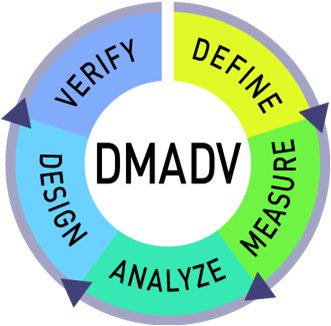DMADV is a methodology within the Six Sigma framework, which stands for Define, Measure, Analyze, Design, and Verify. DMADV is primarily used for designing new processes, products, or services that meet customer requirements and are defect-free from the start. Let’s delve into the key phases of DMADV:
- Define: The define phase in DMADV is similar to the define phase in DMAIC. It involves clearly defining the project goals, objectives, and customer requirements. A project charter is created to outline the scope, team members, and overall objectives. The focus is on understanding the customer needs and expectations for the new process or product.
- Measure: In the measure phase of DMADV, relevant data is gathered to establish a baseline and quantify the current state of the process or product. This includes collecting data on process performance, customer feedback, and market research. The data helps identify the critical-to-quality (CTQ) characteristics and metrics that need to be considered in the design phase.
- Analyze: The analyze phase in DMADV involves analyzing the collected data to gain insights and identify design objectives. It focuses on understanding the relationships between various factors and their impact on the desired outcomes. Tools such as process mapping, cause-and-effect diagrams, and statistical analysis are used to analyze the data and identify potential design inputs and requirements.
- Design: The design phase is the core of the DMADV methodology. It involves developing and designing a new process, product, or service that meets the identified requirements and objectives. During this phase, various design concepts are generated and evaluated. Prototyping, simulations, and design of experiments (DOE) techniques are commonly used to refine and optimize the design. The goal is to develop a robust and efficient solution that can deliver the desired outcomes.
- Verify: The verify phase in DMADV is focused on validating the designed solution. It involves testing and verifying the new process, product, or service through pilot runs or simulations. The performance is evaluated against the defined metrics and requirements established in the measure phase. The feedback and results obtained during this phase are used to refine and finalize the design before full-scale implementation.
DMADV provides a systematic and structured approach to design and develop new processes, products, or services that meet customer expectations and minimize the risk of defects or failures. It emphasizes understanding customer needs, analyzing data, and using statistical tools to guide the design process. The goal is to achieve a high level of quality and customer satisfaction right from the beginning, rather than relying on post-production improvements or defect reduction.
It’s important to note that DMADV is not always used in every Six Sigma project. It is typically applied when there is a need for designing a new process or creating a new product or service. DMAIC, on the other hand, is more commonly used for problem-solving and process improvement projects.
 (909) 987-1774
(909) 987-1774 Email Us
Email Us








